My Life In The Bush
Izak Barnard is a living legend in Southern Africa. The son of a famous hunter and notorious poacher and outlaw, he inherited his father’s love for the bush and the people, animals and plants that inhabit it...
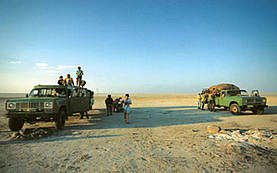
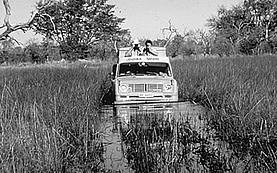
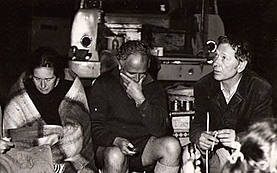
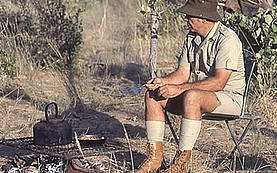
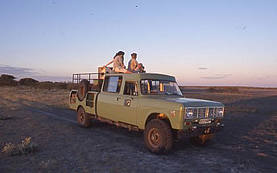
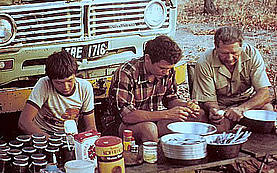
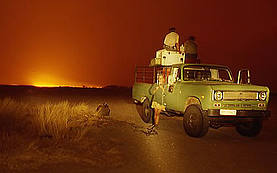
He is a modest and unassuming person, with the true humility of someone who observes and respects the forces of the Nature, and in this article he lets us glimpse something of these observations through his own eyes.
“When I think back to the early sixties, I remember clearly how I felt when, on trying to get a party of people together to visit Botswana; they replied that of course they would go if I paid them. I suppose on reflection that it was to be expected. The salt pans, the lonely sand dunes of the Kalahari, the forests and game tracks, had only been explored by the locals, who knew every facet of the land as well as they knew the lines of their own hands. I had just a taste of this knowledge and was so captivated that I believed that everyone would be as fascinated as I was.
In fact it was only in 1963 that I managed to persuade three people to join me on my travels, and that was on condition we shared the costs. Of course it didn’t matter. I had the opportunity for the first time of sharing some of the pleasure which Botswana gave me. That was the start. These days there is no need for persuasion, the country is appealing to an increasing number of people, and by December 1984 I myself will have taken 13 tours this year. If we go to the west Kalahari, it is for about twelve days, if to the Okavango, it is for 15 days, and we do special charters and cater for special interests like insect or bird life. I am lucky that this has become my profession, because Botswana is the focal point of my life. The silence of the dune country and the waterways of the Okavango are part of me. I hate cities, three hours in a city is enough, but I like people and this is what has made me want to share the Botswana wilds, to open doors to the people, and let them realize there is more to life than cars and offices and ice-cream. I first went into the bush in Botswana when I was 23. Even as a child, I had heard stories of it. My grandfather and uncle were in Botswana as early as the 1880’s and my mother was born at Kayne on the way back from Lake Ngami. My father Cecil Barnard was a notorious poacher, outlaw and hunter in that corner of South Africa where the present day Kruger Park meets Mocambique and Gonarezhou in old Rhodesia. You could say that he was famous. He was the king of the ivory poachers, and the Shangaans called him “Bvekenya” (the one who swaggers when he walks) and Bulpin wrote a book about him entitled “The Ivory Trail”.
By the time I was born, my father had put that way of life behind him, and was a farmer. But of course it was natural enough that the stories I heard would fire my imagination. Still it was my first meeting wit the Bushmen that really changed my life and it happened as late as 1962. I can remember clearly the very day – June 3rd 1962 – so great was the impact of that meeting.
Travels had taken me to Lethlakeng, and there they were – my first real contacts with the Bushmen world. They carried their traditional bows and arrows, and when darkness fell thy danced and sang until late into the night. I gave them tobacco and sat talking to them for many hours, and it came to me then how well these people understood the ways of animals, and how very much they could teach me.
The following year in Lokgwbe I met the leader of Nama Hottentot people of Botswana, a man called Simon Kooper, the son of General Simon Kooper who fought in the German-hottentot Herero wars, and a stronger link was forged. Simon and I became close friends, and it was he who took me into his world of the Kalahari, to hundreds of salt pans where Europeans had never ventured, and it was Simon who taught me virtually all the bush-lore I know. He taught me common sense things, related to survival in the veld, where to get moisture in a waterless land, animal tracks, things like that.
Animal tracks are like road signs, and today I can tell you how old a track is and when it was made, whether last night after midnight or this morning at six, and I can tell you what animals had passed, from the biggest elephant to the tiniest elephant shrew. This I learnt from my tutor. Later Simon took me to the Kalahari dunes for the first time.
There was no water, just animals and desert and a deep silence. After that I started to go further and deeper into the Kalahari and to the Okavango, trying to get information about the area, but it was difficult. Nobody was interested except the hunters who only wanted to shoot, and I, who have never hunted and never carry a gun in the bush, used to go in on my own a lot and bring back cuttings of flowers and trees for identification. During the first three-man safari in 1964 Simon agreed to be our guide, and he took us to the saltpans. It was a rough journey, but that is my idea of a safari in any case.
To my mind it should never be cushioned by iced water or air conditioning and brandies. To get to know a country as it really is you have to “feel” it, the good and the bad, feel the heat and the ruts, and bump over the roads of the country in a land rover, experience the heat of the earth underfoot at 80 degrees and drink from the surroundings, which may mean water hot enough to make a cup of tea.
There are compensations, because then you become part of the terrain. Otherwise, you might as well be a spectator sitting watching a film of Botswana. I think that to know the bush you must get under the skin of it like the Bushmen do. The Bushmen are wonderful people. They understand the veld and the animals they are our link between ancient and modern man, between man and the animals, and this fragile tenuous link will be gone before too long. I know that. Scientific research has been carried out into the Bushmen’s way of life, but it cannot quite capture the essence, which already is gradually being lost. The link weakens each year, because, as a wild animal when it is caged loses its instinct for survival, so it is with the Bushmen. They come to work in the kraals and on the farms, and they slowly lose their age-old knowledge and their instinctive ability to become part of the bush world. It seeps away like water spilt in a dry country. Wasted and unrecoverable.
As I speak I am about to go into the Kalahari with a group of filmmakers who, although still awaiting government permission, are looking at the Kalahari as a possible location for a film.
The theme of this film sums up what I have said. It is the story of a boy from the computer age, used to hi-fi’s and microchip technology, who through circumstances is lost in the Kalahari and only survives because of the help shown him by the Bushmen. The film demonstrates how the western world with all its advanced knowledge is useless in a bush situation.
I am going with the filmmakers to look for a location. It will not be difficult to find because Botswana is a wonderful place for filming. The industry is beginning to become aware that the light, skies and sand dunes and dust storms of Botswana, all free of charge, are a more exciting location than the Californian desserts or the simulation of a dust storm n Hollywood studios.
Botswana, you see has many facets, and it has the added magic and mystery of being partially unexplored. There are areas of Botswana which even today are barely known. For instance, at the moment I am still exploring the areas that only the Bushmen know well. When you think of explorers it is interesting to identify who the first real explorers of Africa were. It was the elephant who were the great trailblazers and the whole of Africa was explored initially on the game tracks. The humans went down game trails which led from one waterhole to the next and, because elephants need water, and cannot go for more than 2 days without it, the elephant tracks were lifesavers for humans exploring Africa. Elephants are heavy. They don’t take high hard trails, but keep to the simplest easiest routes, especially where mountains and hills are involved. Following the game trails made building Long Tom Pass in Eastern Transvaal simple for the engineers.
Botswana used to be alive with elephant. In Ngamiland, over 100 years ago, there were enormous herds of them. The place was quiet and isolated and tsetse infested, which was a protection for the elephants because they could move about without danger in tsetse fly areas, but the hunters with their horses were deterred.
The locals in Ngamiland took the elephant for granted. They used the ivory quite practically occasionally forming stockades out of tusks and sinking them into ground like fence posts. A white hunter who stumbled across this treasure could not believe his eyes. Can you imagine? To western eyes it was like using a handful of diamonds as pot scourers. He traded guns for their ivory palisades and returned loaded with the greatest hoard of tusks ever seen in those parts. His friends, sour at his success, remarked that the ivory looked old and suspiciously earth stained, so he invented a story to bemuse them. A story of a graveyard where the elephants went to die, a plausible tale because having heard it a lot of people set forth to look for the legendary graveyard. In their travels they found the source of the Okavango River instead. To this day the legend of the elephant graveyards lives on and it has been repeated so many times that a good many people believe it.
Without doubt elephants are my favorite animals.
They are a matriarchal society. A family group comprises mother, daughter, and granddaughters, and very small bulls that, when they reach maturity, go to live with the other bulls. Bulls move in heads of 30/35 but even when they leave their own herd to breed in a family group, it is always the mother who retains leadership. She moves with her children in a migratory safari, educating them about plants which are good to eat, about waterholes and routes to follow. On her death it is her daughter who, after perhaps 20/30 years of moving, with the group and absorbing tuition, is knowledgeable enough to take over. You can see from this that if a matriarch is shot it is disastrous. It is better to shoot a whole herd than to destroy the leader, for when she is gone; the elephant herd goes into disarray because it can no longer draw on her wisdom for its survival.
All animals of the bush are fascinating, but so are the insects and all plant life.
They are all connected. Everyone does a bit for nature, and nature plays its part for them. Nothing is meaningless and nothing without function. For example, people say that the elephants destroy the forests, but they are largely responsible for the growth of new trees. Elephants break down climax forests and, by doing that, create living space for new plants to grow, and also for other species to introduce themselves. Elephants also carry half indigested seeds and drop them in their wet dung, which remains moist for a few days. The seed germinates and suddenly there is a new tree. But the trees themselves need protection or they will be devoured piecemeal. To give you an example, the combretums have a unique protection method. An animal can have a few mouthfuls of combretum and them, as a defense mechanism, the tree produces a high level of very unpalatable tannic acid. So the greedy eater is rationed. A few pleasant bites of combretum and then a mouthful of tannic acid.
The acacia protects itself as well. With forty two percent of the weight of an acacia leaf being pure moisture, it makes a wonderful meal in a dry land, so for protection it relies on its thorns.
Another fascinating thing is the different ways animal eat. You get broad mouthed animals like zebra, buffalo, and hippo, who are grazers, and you get narrow lipped animals like giraffe, which prefer browsing. But even here the animals interrelate. The eland, which is a narrow-lipped animal and cannot eat very long grass, will graze alongside animals that can. He will follow them and wait for them to mow the tall grass down to a manageable length before he moves in to graze.
Nature operates in a balanced and wonderful way. There is interaction between everything and everyone.
t is when you upset the balance that the effects are far reaching and detrimental. If you can get enough people to understand this and what happening around them, I believe we will win the conservation battle.
It is true that man has been destructive to the environment and that because of this some animals, shrubs and birds are now extinct, but we can preserve and treasure what we still have left. It is not too late.
After one of my safaris there are always two or three people who, while with us, have seen and understood for themselves the importance of conservation and thereafter they carry the torch for conservation. It is this that makes my job so worthwhile to me.”
Published:
Marung – Air Botswana February 1985